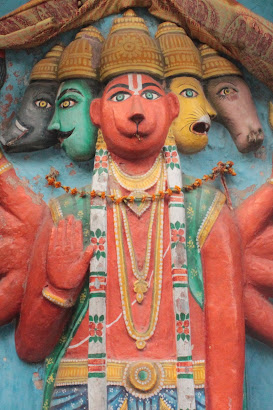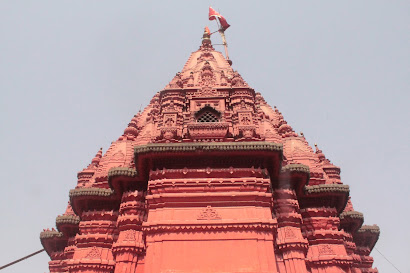I have visited Varanasi on several occasions, on work, and to explore the city. My most recent trip was in 2010. I have been fascinated by the magnetic pull of the Kashi Vishwanath Temple, and the Ghats along the banks of the River Ganga. People are drawn here by the millions, and the city is one of India's most popular pilgrimage sites. The narrow by-lanes in the heart of the city, where there is no scope for vehicles to go, have left me amazed. I have enjoyed going on boat rides along the River Ganga, admiring the temples and grand structures along the Ghats.
Varanasi also holds a special place in my heart, because it was here that my father proposed to my mother, at Clarks Hotel, way back in December 1964. She said yes, and they got married a week later and left for New York, where my father was posted back then.
Varanasi, also known as Benaras or Kashi, is
situated in the eastern part of Uttar Pradesh, India’s most populous state. It
has a population of over 1.2 million. The city lies along the banks of the
River Ganga,
and is one of India’s holiest cities. Buddha is supposed to have founded
Buddhism here in 528 AD, when he preached in Sarnath,
just outside the city. The Mughal Emperor Akbar patronised the
city and built two large temples here. A lot of the current city dates back to
the 18th century, to the period of the
Marathas and the Brumihar Brahmin kings.
Hindus believe that dying here and
being cremated along the banks of the River Ganga allows one to attain
salvation and break free from the cycle of rebirth. The city is best known for
its Ghats along the river, and two of the Ghats are used for cremation. Varanasi
has over 23,000 temples, and the most famous one is the Kashi Vishwanath
Temple. The city is also a big cultural hub, and several prominent writers,
poets, musicians and philosophers have come from it. It also has the famous Benaras
Hindu University, one of Asia’s largest residential universities.
The Ghats are riverside steps
leading down to the River Ganga. Varanasi has 88
Ghats. Most are for bathing and prayer ceremonies, and two are for cremations. A majority of the Ghats date back to the 18th century, and were made under the Marathas.
Prayag Ghat is one of the city's most prominent Ghats.
 |
Prayag Ghat
|
 |
Linga, Prayag Ghat
|
 |
Nandi Statue, Prayag Ghat
|
Dashashwamedh Ghat is another one of the best known Ghats. It lies close
to the Kashi Vishwanath Temple. Every
evening, the Ghat sees an “Agni Pooja” dedicated to Lord
Shiva, the River Ganga, the Sun God Surya,
the Fire God Agni, and the whole universe. A lot of believers find this to be an extremely spiritual experience.
 |
Dashashwamedh Ghat
|
 |
Deity at Dashashwamedh Ghat
|
There are many other Ghats in Varanasi, including Darbhanga Ghat, Digpatiya Ghat, Manikarnika Ghat (where cremations take place) and Nepali Ghat.
 |
Darbhanga Ghat
|
 |
Digpatiya Ghat
|
 |
Manikarnika Ghat
|
 |
Nepali Ghat
|
Kashi Vishwanath Temple lies
not far off from the Ghats. It is dedicated to Lord Shiva. It is one of the 12 Jyotirlingas, the holiest of
Shiva temples. The temple was destroyed several times in its history, most
recently by Emperor Aurangzeb in 1669. The present temple dates back to 1780,
when it was built by Maharani Ahilyabai Holkar. The temple went through several rounds of
expansion subsequently. In 1835, Maharaja Ranjit
Singh donated 1 ton of gold to plate the temple’s dome.
 |
Kashi Vishwanath Temple
Image From Public Domain |
Durga Mandir is
dedicated to Goddess Durga. It dates back to
the 18th century and was built by Rani Bhabani of Natore.
 |
Durga Mandir
|
Shri Vishwanath Temple is situated inside Benaras Hindu University.
The temple was built by the Birla family and was completed in 1966. The
temple’s tower is 77 meters high, and is made largely of marble.
 |
Shri Vishwanath Temple
|
Bharat
Kala Bhawan is a museum inside
the Benaras Hindu University
campus. The museum moved to its present location in 1962. The artefacts on
display include Buddhist and Hindu sculptures, paintings, Miniature paintings
from the Mughal era, textiles,
pottery, jewellery and ivory items.
 |
Alice Boner's Creation, Bharat Kala Bhawan
|
 |
Dancing Ganesha, Bharat Kala Bhavan
|
 |
Shiva and Parvati, Bharat Kala Bhawan
|
Varanasi is certainly a fascinating city. It has that unique spiritual energy that is very uplifting. I was sad to see that the Ghats were not kept clean, and hygiene was a real concern. That really took away from what would have otherwise been an amazing experience. However, from what I've heard, in recent years, there have been huge efforts to clean up the Ghats and the River Ganga. With these enhanced steps, Varanasi is undoubtedly a place not to be missed by pilgrims, by travelers interested in temple architecture, and by visitors who are interested in Hinduism and the spiritual side of India.















No comments:
Post a Comment